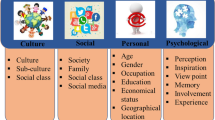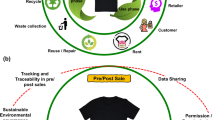Abstract
There is little in-depth research that can assist designers to use culture as a catalyst for designing innovative products within Botswana’s context. The concept of culture and design are intertwined, thus modifications stemming from cultural evolution both reflect and determine developments in design. The paper discusses an experimental design approach conducted at the University of Botswana and participants challenge was to transform and encode socio-cultural factors into product design features. The paper concludes by discussing a model which has shown one way concerning how to consciously specify, analyse and integrate socio-cultural factors in the design process.


Similar content being viewed by others
References
A Framework for a Long Term Vision for Botswana-2016. (1996). Presidential task group for a long term vision for Botswana. Gaborone: Government Printer.
Akin, O., & Lin, C. (1996). Design protocol data and novel design decisions. In N. Cross, H. Christiaan, & K. Dorst (Eds.), Analysing design activity. Chichester: John Wiley and Sons.
Aula, P., Pekkala, J., & Romppainen, J. (2003). Modeling the socio-cultural context. ACM. Retrieved July 8, 2005, from http://www.urova.fi/mode/dppi03.pdf.
Aykin, N. (Ed.). (2005). Usability and internationalization of information technology. New York, USA: Lawrence Erlbaum.
Bryman, A. (2001). Social research methods. Oxford: Oxford University Press.
Carley, K. (1990). Content analysis. In R. E. Asher (Ed.), The encyclopaedia of language and linguistics. Pergamon Press: Edinburgh.
Chapman, J. (2005). Emotionally durable design: Objects, experiences and empathy. London: Earthscan.
Chong, M. (2004). Designing the user experience for international web users. In M. Kaplan (Ed.), Cultural ergonomics. Elsevier: Amsterdam.
Cross, N., Christiaan, H., & Dorst, K. (1996). The delft protocol workshop. In N. Cross, H. Christiaan & K. Dorst (Eds.), Analysing design activity. Chichester: John Wiley and Sons.
Delaney, M., McFarland, J., Yoon, G. H., & Hardy, T. (2002). Global localisation, innovation—global design and cultural identity. Innovation, Summer, 46–49.
DeLarge, C. A. (2004). Storytelling as a critical success factor in design processes and outcomes. Design Management, 15(3), 16–21.
De Souza, M., & Dejean, P. H. (1999, April). Interculturality and design: Is culture a block or encouragement to innovation? In Paper presented at the Design Cultures—An International Conference of Design Research, Sheffield Hallam.
Dorst, K. (1996). The design problem and its structure. In N. Cross, H. Christiaan & K. Dorst (Eds.), Analysing design activity. Chichester: John Wiley and Sons.
Fernandes, T. (1995). Global interface design. London: Academic Press.
Gaver, W. (2001). Cultural probes—probing people for design inspiration. Interaction, 8(5), 51–57. doi:10.1145/382899.382907.
Hugo, J. (2002, February). HCI and multiculturalism in Southern Africa. In Paper Presented at the Design Education Conference, Cape Town.
ICSID. (2002). Facts about ICSID. Retrieved November 1, 2004, from http://www.icsid.org/.
Jason, H. (1997). Patterns in oral literature. Hague: Mouton Publishers.
Kaplan, M. (2004). Introduction: Adding a cultural dimension to human factors. In M. Kaplan (Ed.), Cultural ergonomics. Amsterdam: Elsevier.
Kaptelinin, V. (1996). Computer mediated activity: Functional organs in social and developmental context. In B. A. Nardi (Ed.), Context and consciousness. Cambridge: MIT Press.
Kersten, G. E., Matwin, S., Noronha, S. J., & Kersten, M. A. (2000). The software for cultures and the cultures in software. In H. R. Hansen, M. Bichler, & H. Harald (Eds.), Paper Presented at the 8th European Conference on Information Systems, Vienna, pp. 509–514.
Kotro, T., & Pantzar, M. (2002). Product development and changing cultural landscapes—is our future in “snowboarding”. Design Issues, 18(2), 30–45. doi:10.1162/074793602317355765.
Krippendorff, K. (1980). Content analysis: An introduction to its methodology. Beverly Hills: Sage Publications.
Krippendorff, K. (2006). The semantic turn: A new foundation for design. London: Taylor and Francis.
Kuutti, K. (1999). Activity theory as a potential framework for human–computer interaction research. In B. A. Nardi (Ed.), Context and consciousness. Cambridge: MIT Press.
Lee, K. P. (2004, November). Design methods for cross-cultural collaborative design project. In Paper Presented at the Design Research Society International Conference: Futureground, Melbourne.
Leedy, P. D., & Ormrod, J. E. (2001). Practical research planning and design. New Jersey: Prentice-Hall.
Manzini, S., & Susani, M. (Eds.). (1995). The solid side. Eindhoven: V+K Publishing.
Marzano, S. (2000). New values for the new millennium Philips Corporate Design. Eindhoven: V+K Publishing.
Miller, E. (2002). Face-to-face storytelling. New Delhi: Tamil Nadu.
Moalosi, R., Popovic, V., Hickling-Hudson, A., & Kumar, K. L. (2005). Integrating culture within Botswana product design. In Paper Presented at the International Design Congress, Yunlin.
National Policy on Culture. (2002). Ministry of Labour and Home Affairs. Gaborone: Government Printer.
Norman, D. A. (2004). Emotional design: Why we love (or hate) everyday things. New York: Basic Books.
Onibere, E. A., Morgan, S., & Mpoeleng, D. (2001). Human-computer interface design issues for a multi-cultural and multi-lingual English speaking country—Botswana. Interacting with Computers, 13, 497–512. doi:10.1016/S0953-5438(00)00052-7.
Ono, M. M. (2002). Emergent strategies for designing new products facing cultural diversity, within the globalisation context. In Paper Presented at the 2nd Conference on Innovative Research in Management, Stockholm.
Papanek, V. (1984). Design for the real world—human ecology and social change. London: Thames and Hudson.
Popovic, V. (1996). Design activity structural categories. In N. Cross, H. Christiaan, & K. Dorst (Eds.), Analysing design activity. Chichester: John Wiley and Sons.
Popovic, V. (2002). Activity and designing pleasurable interaction with everyday artifacts. In P. W. Jordan & W. S. Green (Eds.), Pleasure with products: Beyond usability (pp. 367–376). London: Taylor & Francis.
Press, M., & Cooper, R. (2003). The design experience: The role of design and designers in the twenty-first century. Burlington: Ashgate.
Reinharz, S. (1992). Feminist methods in social research. New York: Oxford University Press.
Röse, K. (2004). The development of culture-orientated human machine system: Specification, analysis and integration of relevant intercultural variables. In M. Kaplan (Ed.), Cultural Ergonomics. Amsterdam: Elsevier.
Saha, A. (1998). Technological innovation and Western values. Technology in Society, 20, 499–520. doi:10.1016/S0160-791X(98)00030-X.
Schein, E. (1999). The corporate culture survival guide. San Francisco: Bass Jossey.
Silverman, D. (2001). Interpreting qualitative data methods for analysing talk, text and interaction. London: SAGE Publications.
Taylor, A. J., Roberts, P. H., & Hall, M. J. D. (1999). Understanding person-product relationships–A design perspective. In W. S. Green & P. W. Jordan (Eds.), Human factors in product design. London: Taylor & Francis.
Tyan-Yu, W., Chi-Hsien, H., & RungTai, L. (2004). The study of Taiwan aboriginal culture on product design. In Paper Presented at the Design Research Society International Conference: Futureground, Melbourne.
Van Raaij, F. W. (2005). Applied consumer behaviour. London: Longman.
Weber, R. P. (1990). Basic content analysis. London: SAGE Publications.
Yang, X. Y. (2003) Culture—trends for contemporary design in the 21st century. In Paper Presented at the 6th Asian Design Conference. Retrieved August 21, 2005, from http://www.idemployee.id.tue.nl/g.w.rauterberg/conference/CD_doNotOpen/ADC/program.html.
Zec, P. (2002). Lifestyle and product culture for a global age: Good design. Innovation, Summer, 34–38.
Author information
Authors and Affiliations
Corresponding author
Rights and permissions
About this article
Cite this article
Moalosi, R., Popovic, V. & Hickling-Hudson, A. Culture-orientated product design. Int J Technol Des Educ 20, 175–190 (2010). https://doi.org/10.1007/s10798-008-9069-1
Received:
Accepted:
Published:
Issue Date:
DOI: https://doi.org/10.1007/s10798-008-9069-1




